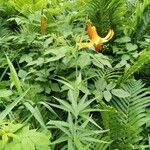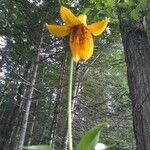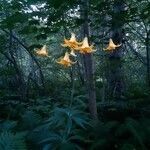Bulbs usually yellowish, rhizomatous, unbranched, 1.8–4.5 × 4.2–11.7 cm, 0.3–0.8 times taller than long, 2(–3) years’ growth evident as annual bulbs, scaleless sections between these 0.7–5.3 cm; scales 1–2-segmented, longest 0.9–2.8 cm; stem roots present, often very many. Stems to 1.8 m. Buds rounded in cross section. Leaves in 6–10 whorls or partial whorls, 3–12 leaves per whorl, ± horizontal, occasionally slightly ascending, drooping at tips, 4–17.3 × 1–3.6 cm, 2.5–10 times longer than wide; blade narrowly elliptic, occasionally elliptic or slightly lanceolate, margins not undulate, apex acute, often acuminate in distal leaves; principal veins impressed adaxially, veins and margins very noticeably roughened abaxially with small ± deltoid epidermal spicules. Inflorescences racemose, 1–17-flowered. Flowers pendent, not fragrant; perianth ± campanulate; sepals and petals somewhat recurved 1/2–3/4 along length from base, adaxial surface dirty yellow proximally and giving way to red dusting on tips, red or pale red abaxially, or orange adaxially and yellow-orange abaxially, or both surfaces solid yellow, spotted maroon, not distinctly clawed; sepals not ridged abaxially, 5.4–8.5 × 1.2–1.7 cm; petals 5.3–8 × 1.2–2 cm; stamens barely exserted; filaments ± parallel to style, barely spreading, diverging only 4°–6° from axis, ± same color as sepals and petals; anthers dull magenta or darker, 0.6–1.3 cm; pollen rust, sometimes light brown, rust-, tan-, or orange-brown; pistil 4.2–6.4 cm; ovary 1.5–2.8 cm; style ± same color as sepals and petals; pedicel 5–23.5 cm. Capsules 3–5.2 × 1.5–2.3 cm, 1.5–2.5 times longer than wide. Seeds not counted. 2n = 24.
More
Stem slender, erect, 6–15 dm, smooth; lvs mostly in 6–11 whorls of 4–12, the lowest regularly and a few of the uppermost occasionally alternate; lf-blades lanceolate to linear-elliptic, widest at or below the middle, tapering to both ends, often spiculate-scabrous along the margins and veins beneath, the largest 8–15 cm × 8–20 mm; fls 1–5, nodding from long pedicels; tep narrowly oblanceolate, acuminate, only slightly or moderately recurved, 5–8 cm, yellow or orange-yellow, varying to sometimes nearly red, marked with purple spots within; filaments straight or nearly so, only the juxtaposed anthers evidently exserted; fl-bud subterete; 2n=24. Moist or wet meadows; Que. and Me. to Md. and in the mts. to Va., w. to O., Ky., s. Ind., and Ala. June–Aug.
A bulb plant. It grows 90-180 cm high and 25-30 cm wide. The flower stems are long and arched. The flowers are carried up and out from the stem. The bells hang vertically. There can be 20 flowers. They have a light scent. They vary in colour from yellow to orange or red. They usually have dark spots on the inside. The flowers are 5-8 cm long. The segments turn up gently at the tips.
Wet meadows, moist rich woods especially edges, streamsides and river alluvia, bogs, marshes, swamps, along wet roadsides and railroads; from sea level to 1,000 metres.
More
It is a temperate plant. It is frost hardy. It needs moist lime free soil. It grows in rich moist soil, wet meadows, and ditches. It suits hardiness zone 6.




